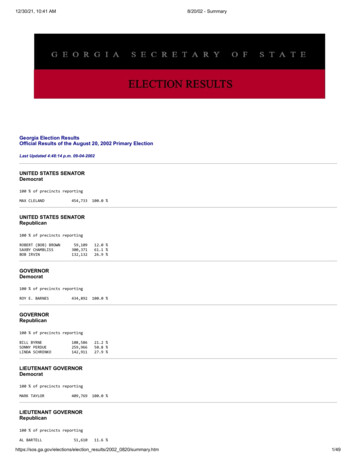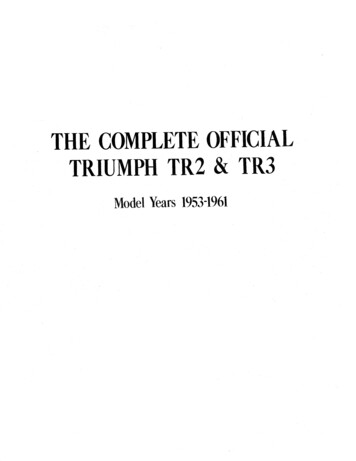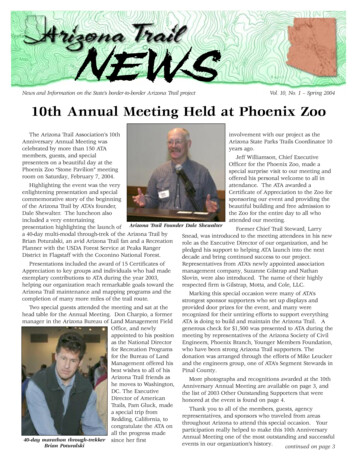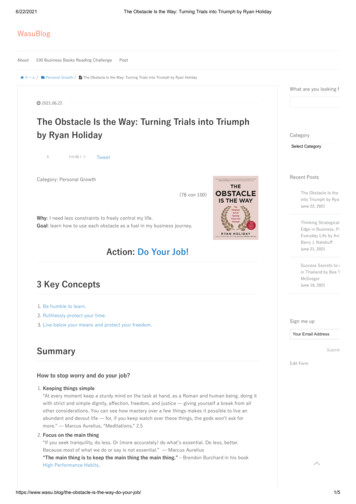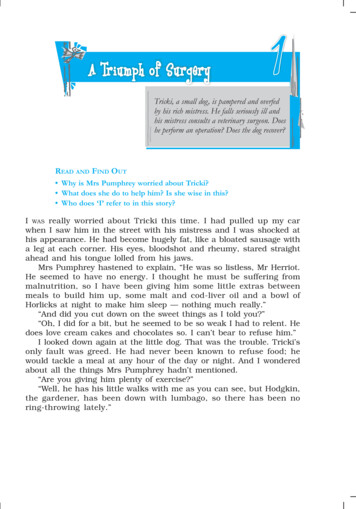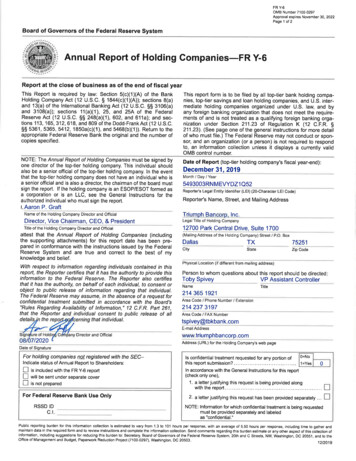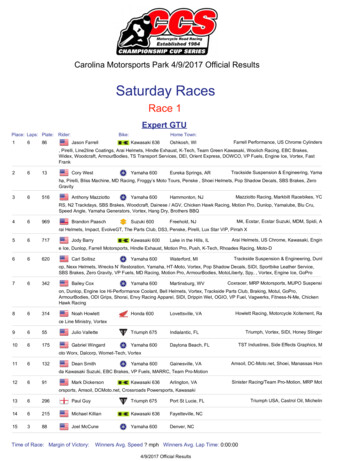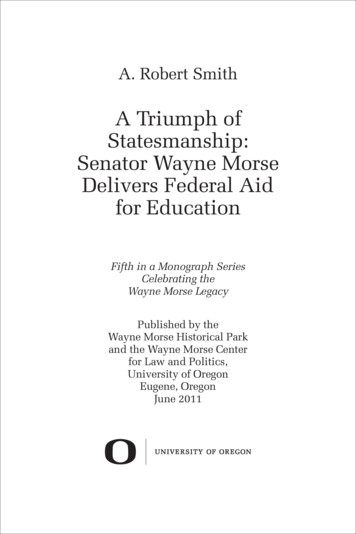
Transcription
A. Robert SmithA Triumph ofStatesmanship:Senator Wayne MorseDelivers Federal Aidfor EducationFifth in a Monograph SeriesCelebrating theWayne Morse LegacyPublished by theWayne Morse Historical Parkand the Wayne Morse Centerfor Law and Politics,University of OregonEugene, OregonJune 2011
PrefaceThe Wayne Morse Legacy: A Monograph Series“Wayne Morse is our reminder, forever, that one man withunlimited courage can move mountains of apathy anddespair.”–Joseph L. Rauh Jr., attorney, civil rights activist, andformer occupant of the Wayne Morse Chair for Law andPoliticsThe Wayne Morse Legacy series of monographs is intended tohonor the life and work of Senator Wayne L. Morse by examining key policy areas in which he was involved and had an impact.The series is a continuing project of the Wayne Morse HistoricalPark Corporation and the Wayne Morse Center for Law and Politicsat the University of Oregon.The monographs preserve knowledge of Morse’s colleagues andfriends as well as present interpretations by a new generation ofscholars. They are not academic or technical works. Rather, themonographs are intended to be original and accessible essays for thegeneral public, students, and scholars. This is in keeping with theWayne Morse Center’s role as a “citizen academy” that celebrates,through speakers, conferences, and publications, the Morse idealsof intellectual independence and integrity. The Wayne Morse ParkBoard aims to help people learn and understand the legacy of Senator Morse and how he gave to others even as he served them.The corporation board and the center believe that Wayne Morse’scontributions illustrate the Webster definition of history that speaksof “acts, ideas, or events that will or can shape the course of the2
future.” These monographs will examine how Morse affected education, natural resource policy, foreign affairs, human and civil rights,and labor and industrial relations.The current monograph, the fifth of the series, has been long awaited. It examines in depth Senator Morse’s contribution to U. S. publiceducation. Working with presidents Kennedy and Johnson, Morsesuccessfully guided the landmark legislation that changed federaleducation policies. His legislative leadership was widely praised, andcolleagues and President Johnson began to refer to him as “Mr. Education.”Author A. Robert Smith was on the scene as a journalist covering Capitol Hill for newspapers, including several in the Northwest.Smith was the senator’s first biographer, publishing The Tiger in theSenate well before Morse’s legislative accomplishments detailed inthis monograph. As Smith so aptly observes, Wayne Morse workedpositively with Democrats and Republicans to move American education forward to include all grades and all national areas. It was,indeed, “a giant step for his country.” And it is for readers today apositive example of the value of bipartisanship.Jan Mueller and Laura Olson,Wayne Morse HistoricalPark Corporation BoardMargaret Hallock, Director,Wayne Morse Centerfor Law and Politics3
Table of Contents“For the scholar who began in a one-room schoolhousein rural Wisconsin to become the dean of a majoruniversity was a big personal step; and for the dean tofulfill his ultimate promise in the United States Senate byleaving such an uplifting imprint on American educationwas a giant step for his country.”Preface . . . . . . . . . . . . . . . . . . . . . . . . . . . . . . . . . . . . . . . . . . . . . . . . . . 2About Senator Wayne L. Morse . . . . . . . . . . . . . . . . . . . . . . . . . . . . . . 7About A. Robert Smith . . . . . . . . . . . . . . . . . . . . . . . . . . . . . . . . . . . . . 8Introduction . . . . . . . . . . . . . . . . . . . . . . . . . . . . . . . . . . . . . . . . . . . . 11Uncle Sam’s Hands Off of Education . . . . . . . . . . . . . . . . . . . . . . . . 12The Land Grant Remedy for Poor Schools . . . . . . . . . . . . . . . . . . . . 12Boosting Practical Skills . . . . . . . . . . . . . . . . . . . . . . . . . . . . . . . . . . . 13FDR Resisted Education Aid . . . . . . . . . . . . . . . . . . . . . . . . . . . . . . . . 14Separation of Church and State Complicates Aid Measures . . . . . . 15Ike Lukewarm . . . . . . . . . . . . . . . . . . . . . . . . . . . . . . . . . . . . . . . . . . . .15Aid Endorsed by White House Conference . . . . . . . . . . . . . . . . . . . . 16Race and Religion Stall Congressional Action in 1950s . . . . . . . . . . 17Sputnik Triggers Limited Action in 1957 . . . . . . . . . . . . . . . . . . . . . . 17Morse a Long-time Advocate . . . . . . . . . . . . . . . . . . . . . . . . . . . . . . . 18The Turning Point: 1961 . . . . . . . . . . . . . . . . . . . . . . . . . . . . . . . . . . . 18Bottleneck Broken . . . . . . . . . . . . . . . . . . . . . . . . . . . . . . . . . . . . . . . . 20A New University for D.C.: 1968 . . . . . . . . . . . . . . . . . . . . . . . . . . . . 23Impressive National Benefits of the Morse Bills . . . . . . . . . . . . . . . . 23The Making of a Statesman . . . . . . . . . . . . . . . . . . . . . . . . . . . . . . . . . 25Appendix . . . . . . . . . . . . . . . . . . . . . . . . . . . . . . . . . . . . . . . . . . . . . . . 275
About Senator Wayne L. MorseAs a law professor and dean of the University of Oregon School ofLaw, a labor arbitrator, and a United States Senator, Wayne Morseleft a deep legacy of commitment to democratic representation, the ruleof law, and intellectual independence to the University of Oregon, to theState of Oregon, and to the nation and its people.During Wayne Morse’s twenty-four-year tenure in the Senate, from1944 to 1968, he was a leader in a wide range of issues, including theantiwar movement, education, civil rights, and international law. He isperhaps best remembered for his historic stance as one of two senatorswho opposed the Gulf of Tonkin Resolution, which initiated U.S. military intervention in Vietnam.Wayne Morse took his first law professorship at the University of Oregon School of Law and became the dean within nine months. At thirty,he was the youngest dean of any American Bar Association-accreditedlaw school in the country. His extraordinary effectiveness as a laborarbitrator eventually consumed Morse’s time and energy to the pointwhere he resigned as dean.Morse’s mission as an arbitrator was to uphold what he saw as thesanctity of the contract, the rule of law in the field of labor relations.Deeply committed to fairness and justice, he was popular both withunions and employers. He later served on the National War Labor Board.When President Eisenhower adopted Taft’s economic policies favoring big business in the early 1950s, Senator Morse left the RepublicanParty and became an Independent. His reason was succinct: “Principleabove politics.” Morse joined the Democratic Party in 1955, but twoyears later he voted against Senate Majority Leader Lyndon B. Johnson’swatered-down Civil Rights Bill, calling it an “unconscionable compromise.” And when John F. Kennedy supported the Landrum-Griffin Act,which weakened unions’ legal protections in the name of rooting outorganized crime, Senator Morse became so outraged that he ran againstKennedy in the 1960 presidential primaries.Morse held the liberal conviction that the purpose of democraticpolitics is not to amass wealth, but rather to enable the country’s truewealth—its people—to flourish. In Morse’s own words: “If you want tounderstand my political philosophy, here’s the basic tenet: I think thejob of a U.S. Senator is to seek to translate into legislation values thatpromote the welfare of people. Because . . . the keystone of the Constitution is the general welfare clause, and the wealth of America is itspeople, not its materialism.”7
About A. Robert SmithThis monograph was written in the spring of 2011 by A. RobertSmith, author of the biography of Wayne Morse The Tiger in theSenate, and a former newspaper correspondent who covered SenatorMorse for The (Eugene) Register-Guard from 1951 until the senator’sdeath in 1974.Before he ever became a reporter, Bob Smith was an admirer ofMorse as a student at Juniata College in Pennsylvania, when he readabout Oregon’s freshman senator whom the Republican Party foundimpossible to control. When hired by The Register-Guard to coverMorse, he found the senator a reporter’s dream to write about—a manof action who had a quotable opinion on everything. Because Morsewas such an outspoken maverick, many people asked Smith, “Whatmakes him tick?”“I didn’t know how to answer them, but I wanted to know and began looking into his background, interviewing members of his familyin Wisconsin, colleagues at the University of Oregon, and other senators, and before I realized it I was preparing a biography,” said Smith.“The senator gave me many interviews for the book, as well as formy newspaper articles. I promised the book would not be publishedduring an election year, but my publisher overruled me and broughtit out in 1962, six months before his re-election. He blasted it in theSenate as part of a campaign to defeat him and barred me from hisoffice for several years.“My only regret about the book is that his finest hours came afterit was published, during his opposition to the Vietnam War and hismonumental achievements in delivering federal aid for education,”said Smith. “This essay is an attempt to fill that gap.”This is a journalist’s account, not an academic paper. Bob reliedheavily on his reporting of events; the senator’s files in the Universityof Oregon’s Knight Library; the Congressional Record; the reportingof Yvonne Franklin; the well-documented account of the educationdebate in Wayne Morse, A Political Biography, by Mason Drukman,published by the Oregon Historical Society Press in 1997; and hisown biography of the senator. He is indebted to Margaret Hallock,8
director of the Wayne Morse Center for Law and Politics, for proposing this project; to Linda Long, the Special Collections librarian atthe University of Oregon, and her student aides for digging into theMorse trove; and to Laura Olson and Jan Mueller, and other keepersof the legend through the Wayne Morse Historical Park Corporation.As a Washington correspondent for twenty-seven years, Smithwrote dispatches that were also published in The Oregonian, theSalem Oregon Statesman, The (Pendleton) East Oregonian, Medford Mail Tribune, The Daily Astorian, The (Bend) Bulletin, and The(Roseburg) News-Review, as well as newspapers in Washington state,Idaho, and Alaska. He wrote a cover story about Morse for the NewYork Times Magazine.Smith is the author of six other books, including Washington, Magnificent Capital, with Eric Sevareid and Fred Maroon, and No SoulLeft Behind, the Words and Wisdom of Edgar Cayce, and is currentlywriting a memoir about his Navy service in World War II in the Pacific and in the trenches of Oregon political journalism, entitled GodGave Me a Mulligan. He has also been an editorial writer for the Norfolk Virginian-Pilot, the editor of Venture Inward magazine, and hasbeen honored by the University of Alaska, the Alaska Press Club, theUniversity of Oregon’s Wayne Morse Center for Law and Politics, theSociety of Professional Journalists, and Who’s Who in America.He resides in Virginia Beach, Virginia, and may be reached atabob@cox.net.9
A Triumph of Statesmanship:Senator Wayne Morse Delivers Federal Aid for EducationIntroductionThe indelible image of Wayne L. Morse is a portrait of an outspoken dissenter, a public servant ever vigilant to protect andchampion the interests of the common man, a fearless maverickbeholden to no party, a tireless critic of those who exploit the manyon behalf of the few. For twenty-four years as a United States senatorfrom Oregon, his aggressive combat with presidents and colleagues ofeither party was relentless. His filibusters against proposals he condemned and his flaming oratory against such issues as “giveaways”of public resources or the Vietnam War both inspired and infuriatedmany.He was truly the Tiger in the Senate.His most lasting achievement, however, and arguably his mostvaluable public service, was of a much different quality. It challengedhim to deliver a priceless gift at the behest of the president he railedhardest against on other issues. Adopting unfamiliar leadershiptactics, framed by an uncharacteristically ingratiating style, WayneMorse succeeded where countless legislators had failed for decadesbefore him: He masterminded the federal government’s most sweeping patronage of public education.Acts of Congress that he piloted through white-water rapids ofpartisan resistance have since then delivered hundreds of billions ofdollars for building and operating schools in every state and territory,at every level, from kindergarten through college. This artful deed—condemned by some as unconstitutional, applauded by progressivesas overdue—was revolutionary.11
Uncle Sam’s Hands Off of EducationHistorically, education has been strictly a state and local responsibility. The federal government had no hand in organizing schools,developing curricula, or determining requirements for enrollmentand graduation. Defenders of local control were determined to keep itthat way out of fear that the overarching bureaucracy would gain aninsidious influence over the minds of our youth.Wayne Morse had no such apprehension, either as a Republican inthe 1940s or as a Democrat from the 1950s on. He was on record asfavoring federal assistance, and during the 1960s assumed leadershipof this movement. It was less a role he sought than a task that fellto him. It was as though he had been called to this assignment. Thepolitical zodiac aligned him as the right man in the right place at theright moment.The condition that cried out for reform was the sorry state ofAmerica’s common schools. The poor education many childrenwere receiving was not recognized until World War I, when the military draft exposed an alarming number of draftees as illiterate. Thisshould not have surprised anyone, for the 1910 U.S. census reported5.5 million illiterates, or 7.7 percent of 71 million American residents. An illiterate was defined as a person ten years or older whowas unable to write in any language. Of these, about 40 percent wereblack, 30 percent immigrants, 28 percent native whites, and 2 percentNative Americans, Chinese, and Japanese. Later surveys measuredfunctional illiteracy at over 20 percent of the population when determined by a tougher standard—those who could not read or writeabove a fifth-grade level.The Land Grant Remedy for Poor SchoolsSuch bleak results of the public school system raised the question, should the national government assume responsibility and takecorrective action? Not that it had never offered assistance—it haddone so generously on several occasions since the Civil War, starting with free land grants. Yet this idea met with resistance from thestart. The first bill granting vast acreage to the states for school support was vetoed as unconstitutional by President James Buchanan in1859. A modified version, the Morrill Act of 1862, was signed intolaw by President Abraham Lincoln. It assisted the states in buildingland-grant colleges to foster learning about farming, engineering, andmilitary tactics.12
The Morrill Act was a most practical remedy because of theabundance of the public domain. The national government, as itscustodian, seized upon the device of giving acreage to the states tosupport various public needs. As early as 1802, when Ohio was admitted to the Union, land granted to the new state carried a provisothat one section (640 acres) in each township was to be set aside forschools. The Ohio formula became the pattern for grants to new statesupon their admission.In all, over 80 million acres was distributed to thirty states as theycame into the Union. Another 3.5 million acres was earmarked forland-grant universities. Eastern states that lacked public lands wereallotted cash instead.The land-grant method was politically appealing because it required no sacrifice in the form of higher taxes or reductions inspending on other government programs. Selling the land to settlersor developers was a natural step in the nation’s growth. It supportedfree common schools for all children, an admirable goal—indeed,it was the linchpin for the wheel of the new democracy that rolledacross the continent.Boosting Practical SkillsThe illiteracy count prompted special remedies to teach Englishto the unlettered, but nothing was done to upgrade school facilities.The one-room country schoolhouse was, for most rural regions, asgood as it got. Congress did, however, authorize funding for instruction in such practical skills as home economics, farming, trade, andindustrial subjects. This law, the Smith-Hughes Act of 1917, has beenamended from time to time to strengthen vocational training, a specialty that found favor across party lines.Attempts to enlarge the role of the federal government in supporting education were impeded by partisanship, the political partiesoddly switching sides over the years. The initial advocate, during the1870s, was a Republican, Representative George F. Hoar of Massachusetts. Hoar was a progressive thinker who campaigned for women’ssuffrage as early as 1886 and opposed the Chinese Exclusion Act of1882. But he was unable to gather support for general aid for education.The first president to recommend federal aid for primary schoolswas also a Republican, Ulysses S. Grant. The Democratic Party platform of 1876 declared the schools to be exclusively a state province.13
The GOP platforms during the 1880s favored national action butCongress was unmoved. Not until the 1920s was the issue raisedanew, inspired by the number of illiterate army recruits. This timethe parties reversed positions. The Democrats favored federal aid toend illiteracy, to increase teachers’ salaries, and for instruction incitizenship, while the Republicans opposed all aid except that for vocational and agricultural training.FDR Resisted Education AidThe 1930s found the Democratic Party avoiding endorsementof an expanded education program because President Franklin D.Roosevelt resisted the idea and even tried to reduce federal aid forvocational training. Congress, however, rejected Roosevelt’s appealand passed a measure in 1936 that expanded the vocational education program. Roosevelt signed the bill, but appointed a committee toreview all aspects of federal education policy.The committee in 1938 recommended a multimillion-dollareducation-assistance program, including assistance to private andparochial schools. Roosevelt did not endorse its report, but pledgedto accept an aid program that limited assistance to those states unableto fulfill their own educational needs. “If a suitable standard is to bemaintained in all parts of the country,” Roosevelt wrote, “the federalgovernment must render aid where needed—but only where it isneeded.”Roosevelt’s restraint may have been influenced by the controversystirred by aid proponents. At a convention of school superintendentsin 1938, Protestant educators expressed fear of Catholic influencein education. They noted that the church already dominated somepublic-school systems, such as New Haven, Connecticut, wheretwo public schools were staffed by nuns. There were warnings thatsubsidizing Catholic schools might revive the spirit of Ku Klux Klanbigotry. George Drayton Strayer of Columbia University’s TeachersCollege cried out: “Let’s not have any church—Catholic, Protestant orJewish—using public money to make propaganda for any policy orbelief peculiar to itself. . . . Keep the public schools public.”The chairman of the president’s committee explained that they hadrecommended that federal aid be limited to free textbooks, bus service, health services, and scholarships, just as several states alreadyprovided parochial schools.Harry S. Truman, upon succeeding Roosevelt in 1945, took a more14
positive stance, endorsing aid to help the states equalize educational opportunities and achieve satisfactory standards. The Senateresponded by passing such a bill, but the House didn’t consider it.After Truman was re-elected, he pressed for it again, and a Housecommittee voted out a bill providing grants to public elementary andsecondary schools, but not private schools.Separation of Church and State Complicates Aid MeasuresThe objection cited by most members of Congress to aiding privateschools, especially those of the Roman Catholic Church, was thehistoric doctrine of “separation of church and state.” Some Catholiclawmakers, however, opposed any aid unless church schools benefited equally.Senator Morse favored helping both private and public schools andtried to resolve the conflict by offering loans for private and parochialschools. But his bill was defeated.This religious conflict stalled further action on Truman’s proposal,leaving both sides searching for an acceptable compromise. One ideathat attracted support was the approach adopted by some states toprovide supplemental assistance, such as school bus service and textbooks, to church schools. But no such bill reached Truman before heleft office.Ike LukewarmThe election of President Eisenhower in 1952 raised a new barrier.He was lukewarm to federal aid, but as pressure for relief from thepublic increased he formed a White House Conference on Educationin 1955 and outlined his position on federal aid:It should be under the control of the family and thelocality. It should not be controlled by any central authority. We know that education, centrally controlled, finallywould lead to a kind of control in other fields which wedon’t want and will never have. So we are dedicated to theproposition that the responsibility for educating our youngis primarily local. At the same time we know that everybody must have a good education if they are properly todischarge their functions as citizens of America.And so we come to the heart of this whole problem. Wewant good facilities on the one hand, and we know that15
there are many areas in which people cannot afford tobuild the schools, to provide the facilities that the populations of that particular area need.If we depend too much on outside help, too much on theFederal Government, we will lose independence and initiative. But if the Federal Government doesn’t step in withleadership and with providing credit and money wherenecessary, there will be a lack of schools in certain important areas. And this cannot be allowed.So this is a problem again where the private citizen, thelocality, the State and the Federal Government all havea function to perform, all have a responsibility to meet—always in conformity with those two basic truths thateducation must be free and it must be good.Aid Endorsed by White House ConferenceThe White House conference concluded that “The schools havefallen far behind both the aspirations of the American people andtheir capabilities. . . . There is growing resolve throughout the nation to close the gap between educational ideals and educationalrealities.” Overall, the conference endorsed federal aid. The administration responded by recommending limited federal assistance—forschool construction only. Democrats stigmatized it as weak comparedto their bill for direct grants for school operations. A compromise wasreached in a House committee, but it was defeated by a conservativeRepublican-Dixiecrat coalition in the House chamber. For by then aneven more volatile issue had arisen to exacerbate the conflict: racialsegregation.In 1954, midway through Eisenhower’s first term, the SupremeCourt rendered the most provocative decision of many years, againstthe entrenched “separate but equal” practice of segregating studentsby race in the public schools of the former Confederate states. Resistance in the South to the court’s verdict was more widespread thanacceptance. How would federal aid treat the “separate but equal”system if states refused to integrate their black and white schools?Surveys showed that most dual systems were unequal in quality, andthe Supreme Court had directed them to integrate, a decision thatmade education policy the hottest political issue in the nation for thenext decade.16
Race and Religion Stall Congressional Action in 1950sAdvocates of general federal aid now faced two turbulent issues,race and religion. Their only success thus far had been in obtaining limited funding to relieve the impact of military bases locatedin school districts. Many schools educate the children of militarypersonnel who live on land that can’t be taxed to support the schoolsystem. The solution was the Lanham Act of 1940, providing federalpayments in lieu of taxes to impacted school districts. Year after yearimpacted aid was doled out while opposition to general federal aidgrew stronger. By 1960 general aid legislation in one form or anotherhad been debated in Congress eighteen times without any legislationenacted. Three times the Senate passed a bill only to see it die in theHouse.While many Republicans simply opposed expanding the federalrole, race and religion were most responsible for the stalemate. Anamendment attached by Congressman Adam Clayton Powell, requiring states to abide by the Supreme Court’s integration mandate inorder to qualify for aid, sparked explosive opposition by most southern representatives.Sputnik Triggers Limited Action in 1957As action languished in Congress, public support grew. It wasstimulated by such popular books as Illiterate America by JonathonKozol and Why Johnny Can’t Read by Rudolf Flesch. An unexpectedinternational development in 1957—the launch of Sputnik—finallytriggered action. The Soviet Union’s initial space success inspiredCongress to adopt the National Defense Education Act, authorizinggrants for the improvement of science, mathematics, and foreign language instruction in elementary and secondary schools, as well asloans to college students and graduate fellowships. Like the militaryimpact aid program, the NDEA had a special national security purpose—to help ensure that America could compete with the SovietUnion in scientific and technical fields.17
Morse a Long-time AdvocateWhere was Wayne Morse during these years of mounting controversy and unfulfilled efforts to enlarge the federal role? As ajournalist covering the Oregon senator from 1951 to 1968, I don’trecall his early focusing on education issues. The big three on hisoverall agenda during his first three terms in the 1940s and 1950swere labor legislation—working against adoption of the Taft-Hartleyand the Landrum-Griffin acts; natural resource policies—opposingthe “giveaways” of natural resources to private power, mining, andoil companies; and foreign policy—opposing Cold War alliances withanti-Communist dictators, among others.Nonetheless, as a Republican, he was one of a minority in the GOPwho favored federal aid for education. In his first term he joinedhis floor leader, Robert A. Taft of Ohio, in cosponsoring federal aidmeasures. Their bill, offering grants to the states for public schoolconstruction, avoided the parochial school issue by allowing eachstate to decide what was the boundary between church and state.The bill passed the Senate by a comfortable margin, 50 to 15, butfloundered in the House over an attempt to exclude Catholic schools.Catholic Cardinal Spellman accused opponents of “religious prejudice against Catholic children.” Eleanor Roosevelt, in her syndicatednewspaper column, said proponents “cannot be accused of prejudicewhen we do not want to see public education connected with religious control of our schools.”The issue was revived during the 1960 presidential campaign. TheSenate took up a bill limited to aiding public school construction.Morse cosponsored a successful amendment broadening the bill toallow states to use the money to improve teacher salaries. Privateschools were excluded when the committee rejected offering themlong-term loans. The National Catholic Welfare Conference, workingbehind the scenes while the bill was being debated, persuaded Morseto offer the loan provision as an amendment during the Senate debate. Morse was not their preference as a sponsor, but he was the onlysenator who would risk it, I was informed. It was rejected 49 to 37.The Turning Point: 1961Prospects for success, however, dramatically improved when President John F. Kennedy took office and Democrats gained control ofboth houses of Congress in 1961. Senator Morse gained a position ofgreater influence than he had ever before enjoyed.18
In his first two terms, as a Republican, Morse served during theadministrations of Democrats, Roosevelt and Truman. When heswitched parties to become a Democrat, a Republican, Eisenhower,became president. In short, until 1961, he had always been a memberof “the loyal opposition,” the party out of power.Had Wayne Morse begun his Senate career as a member of the majority party, perhaps he would not have become the most outspokendissenter on Capitol Hill. That he savored that role, there is no doubt.The circumstances of his first sixteen years in office were too invitingfor him to be anything but the outspoken critic that he became.But now, suddenly, he was on a different playing field. He hadrisen in seniority sufficiently to claim the chairmanship of the SenateEducation subcommittee. An attempt to block his promotion failedwhen Morse threatened an all-out battle with party leaders if he weredenied. With his party in control at both ends of Pennsylvania Avenue, a committee chairmanship gave him an enormous opportunityfor leadership. But many observers questioned whether he couldlead. As the liberal columnist Doris Fleeson put it, could he “keep hishead?” Could he work within the system, a party man instead of anoutsider?President Kennedy had determined to emphasize aid for schools.As the first Catholic president, he undoubtedly bel
egon School of Law and became the dean within nine months. At thirty, he was the youngest dean of any American Bar Association-accredited law school in the country. His extraordinary effectiveness as a labor arbitrator eventually consumed Morse's time and energy to the point where he resigned as dean.
